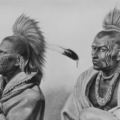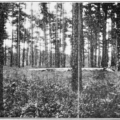The Impassive Listener: Rusty Morrison

A chainlink is an apt image for the way concepts and objects become a single edifice, the way objects and meaning create boundary and enclosure, the way perception becomes partition and frame. It’s easy to forget that at daybreak, “Objects [are] still emptied of resemblance.” The connections and connotations of objects are not innate; we see things first and then ascribe meaning to them. A broken window, to use one infamous example, does not itself carry the essence of a dangerous neighborhood; it only bears our projection of that meaning.
At some point, however, that process becomes instantaneous: “How meanings settle upon the eye.” With a lifetime of practice, the distinction blurs between what we see and what we decide it means.

Beyond the Chainlink
by Rusty Morrison
Ahsahta Press, 2014
$18.00
In her fifth poetry collection, Beyond the Chainlink, Rusty Morrison explores the confluence of perception and meaning. “The journalist’s temptation of measuring meaning against the display ads,” she writes in one poem, questioning the cultural and personal inferences of larger-than-life images. In another she asserts: “A theory of the idyllic is build upon/its refusal to embrace us.” Still elsewhere she observes, “Two yellow chairs turn the wall a blue/that couldn’t exist without them.” Here the use of color is twofold: as description and as influential actor. The perception is an impassive thing, and Morrison employs both to show how the truth is concealed.
The colors in Beyond the Chainlink are relative rather than absolute, a lens through which we give shape to what we see. And as new hues are formed from the interaction of known colors, new meanings are created from the tension between speaking and listening, constructing and interpreting, giving and taking: “Fermented liquor of your listening; emptied cup of my vowels.” Of course the interchange is more complicated than this; speaking is not like pouring liquid into a cup, and the listener is not an empty receptacle. Like the colors that pattern and inflect, the listener is impassive. Each individual has her own interpretations. Later, Morrison revisits this interchange: “I bundle all my slender resurrections, presenting them to you as a bouquet./Amid tariff and back-debt, you collect, like a deranged actuary.”
The relationship between speaker and listener is an exchange, not unlike paying a debt. In Morrison’s words, we are “All sailors in our intricate sentence, no captain.” There is no stable force to decide what a sentence means. This gives us a clue as to how to read Morrison’s work: each line or couplet reads in contrast to the rest. Instead of building her verse around a controlling idea, each poem contains a string of distinct, independent thoughts that interact with one another.
Beyond the Chainlink inhabits transformation: not only of words and meanings but of the material world as well, especially the transformation of the body. “I lean//on my body, hard enough to feel its resins crack.” And: “The body is a cosmos//of hidden atmospheres—each with its own ravage.” The positive and negative spaces in Morrison’s imagery trace the human trajectory from the white wall of innocence to the one tainted with the graffiti of experience. “Every color your white wall receives/from the concealed world.” Later, white is associated with mourning, age, and accident: “Gloves too thick to wear. Milk spilled on the mirror.//One long thick white hair just where, as a child, I imagined/I’d grow one.” In this way, the material takes on added meaning, transforming into the immaterial and symbolic:
Strategy: Bring roses.
Blossoms expoundthorn, plush, perfume, blush—two dozen
long-stemmed rhetorics
Eventually we sense the meaning before even seeing the thing itself:
Watching, we won’t see leaves break through the smooth
finality of surface.Still, we sense limit
budding with bewilderments.
With enough practice, one can recognize the concept (limit) without relying on image (leaves). Similarly, Morrison shows the disparity between signifier—a symbol on a page—and its significance by employing the word impermanence, whose sound belies its meaning:
I install wisps of straw in the damp beach-sand
to court wind. Impermanence—
too long a word for what spins
inside its syllables, what sparks.
The speaker articulates the feeling of impermanence in the first two lines, relying on the image rather than the abstraction. “I install wisps of straw in the damp beach-sand/to court wind” contains mostly one-syllable, plosives and glides that leave the tongue as soon as they arrive.
The temptation is for meaning-makers to overstep their boundaries. At times, says Morrison’s speaker, “flowery words//… blithely neglect their sentence” and you can’t see the proverbial forest for the trees. It’s easy to draw inferences from what’s seen, obscurely, through the chainlink. At one point the speaker describes a kiss during which “sky is wearing for us//her long dress of sunset” and then concedes, “For anyone.” For anyone? Is it even a possibility to project that depth of inner life onto another person?
Morrison reminds the reader that meaning involves a transfer from one world to another—the root of the Greek that gives us metaphor—and from one image to another:
In a dialogic creation of meaning, everything
must be eaten up.Send light back through looking for what else color might become
A whiskey bottle, bread crumbs, full moon, all of our icons,
like traffic, hellbent on getting somewhere.
The images that are part of our cultural landscape are just icons until we “[get] somewhere” with them: until we create new stories to transport everyday images to new meanings. Those who traffic in metaphor and image understand that. Just as psychology consists of the stories we tell ourselves, metaphors are the stories we tell to carve a garden out of the wilderness. Consciousness lies as a possibility within the tangled forest of perception, waiting for a fence to be erected. Metaphors nurture a fuller understanding of the word by making colors into concepts, and consider what the world might become.
About Liza Katz
Liza Katz is a poet, essayist, and teacher. Her work has appeared or is forthcoming in Poet Lore, Omniverse, Burlesque Press, the Quarterly Conversation, and Arts Fuse.





